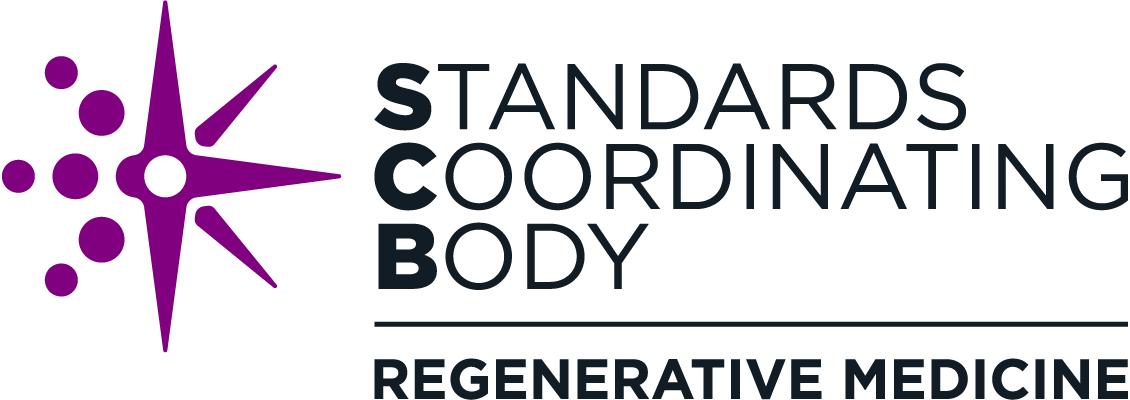Ask SCB: What Key Groups Make Up the Standards Ecosystem?
In this series, SCB Senior Scientific Program Manager Dawn Henke, PhD, and Scientific Program Manager Catherine (Katie) Zander, PhD, answer common questions from the regenerative medicine community.
What are the major groups involved in standards development?
There are eight main groups who participate in standards development. Below is a breakdown of who they are and what they do:
1) ANSI-accredited SDOs (Standards Developing Organizations)
Publish and sell standards
Establish and maintain processes for meeting ANSI requirements for consensus standards development
2) Non-ANSI-accredited SDOs (e.g., pharmacopeias)
Publish and sell standards
May not follow consensus standards development processes consistent with ANSI requirements and therefore may reflect a particular viewpoint on a topic
3) Accreditation bodies
Accredit facilities or professionals who follow certain standards of practice
Help to increase harmonization in standards working groups when they participate
4) Professional societies
Provide a group perspective on certain topics, offering diverse viewpoints
Serve as champions for standards, communicating to their members about available standards, and seeking feedback from members on in-development standards
5) Industry
Primary users of standards
Participate in drafting standards and providing information on the needs and problems the standards can address
6) Academia
Provide scientific and technical viewpoints for the development of standards, particularly for new technologies
Users of the standards, but not to the same extent as industry
7) Clinicians
Help with drafting and providing information for standards, particularly the patient care perspective
Unlikely to be users and are most interested in how the standard will affect patient care and outcomes
8) Regulators
Provide regulatory perspectives during standard development on what is expected in the approval process
Provide insight into overarching challenges for the field
How does SCB fit in among these groups?
We span the eight groups by sharing our knowledge of the standards landscape in regenerative medicine (we actually “wrote the book” on that). We make it easier for people to contribute their expertise to standards by handling standards development procedural steps in different SDOs (e.g., submission of standard drafts and collation of comments) and providing frequent updates on opportunities to participate in standards working groups. We also help find needed experts for standard efforts, ensuring that a broad spectrum of viewpoints are brought to the table. Since we have no vested interest in one group or technology, we are well positioned to help maintain open and fair groups and help stakeholders reach consensus.
How does SCB differ from an SDO?
SCB does not publish standards—we support the development of standards through already established and accredited consensus-based SDOs. We also serve as an unbiased group that can help identify and prioritize resources for the standards needs of the whole regenerative medicine community. Since we have insight into what is going on across the field, we act as a coordinator among SDOs through our Standards Development Forum to increase harmonization, prevent duplication, and ensure standards most needed by the community are brought to the attention of the appropriate SDOs. For example, in the SCB-coordinated bioprinting project, we work with multiple SDOs to ensure that interrelated standards on bioprinting software, hardware, and printability test methods will be consistent and avoid overlap. Additionally, When SCB convenes these groups, it facilitates conversations among them and encourages collaboration. In the SCB’s Standards Development Forum, all the groups discuss and address their shared frustrations and problems.
What challenges do these groups face in standards development that SCB helps address?
Most SDOs have broad scopes—also covering topic areas such as aerospace and food service equipment—and therefore lack the bandwidth to identify granular needs within a particular field such as regenerative medicine. SCB can prioritize and bring the needs of our community to the SDOs, which helps to accelerate the initial pre-development steps of standards advancement.
Standards development traditionally is not a quick process; it can take years. For industry and other groups that help to draft standards, this is a major challenge. Stakeholders participate in standards development on a volunteer basis, and advancement can slow if a standard champion steps down due to competing priorities. As standards are SCB’s priority, we provide continuity to ensure that standards maintain their momentum throughout the process.
In addition, industry and academic stakeholders are often immersed in their own work and may not be aware of activities in the broader community. SCB can connect them to one another and help them understand common challenges and solutions in their area of work. Although standards development may appear slow, paradoxically, the use of standards in manufacturing products can greatly speed those processes.
SCB also serves as a hub of standards information, filling a major gap that had previously existed in the community. Prior to SCB, industry and other groups interested in new standards and opportunities to get involved in standards development needed to search through multiple SDO websites. Making sense of complex SDO processes and unfamiliar information without SCB is often a time-intensive and laborious process. Through the SCB Regenerative Medicine Standards Portal, SCB provides a significantly faster, easier, and clearer way to learn about newly published standards, existing standards, and opportunities to participate in standards development.
Learn More
Check out Organizations Developing Standards for more information on organizations that participate in standards development.
